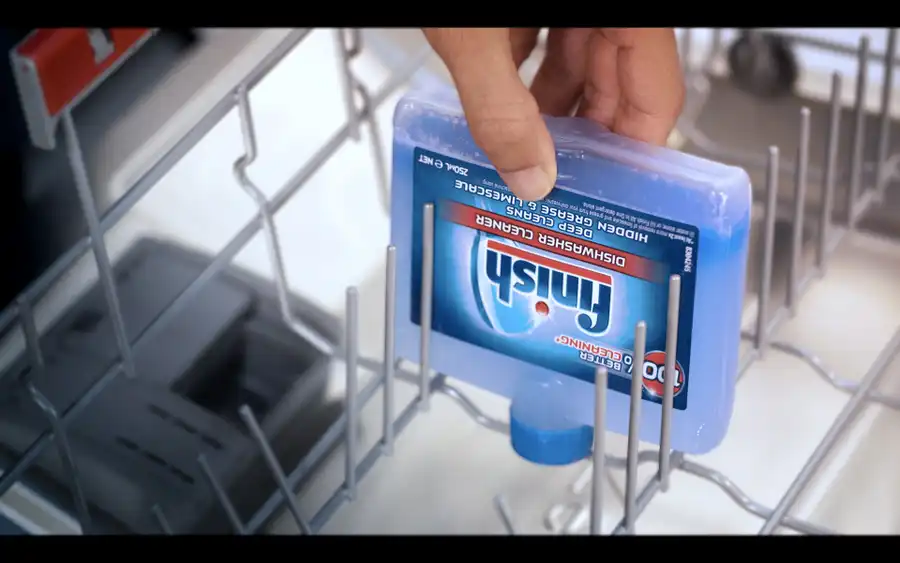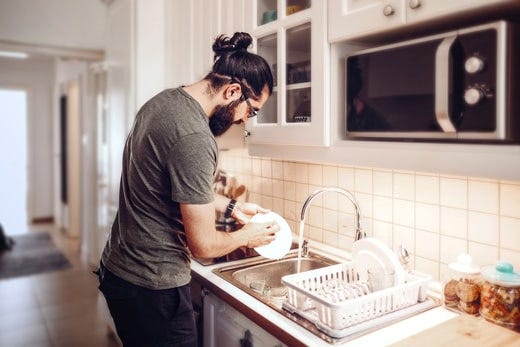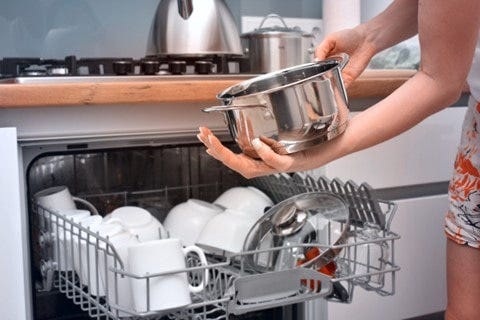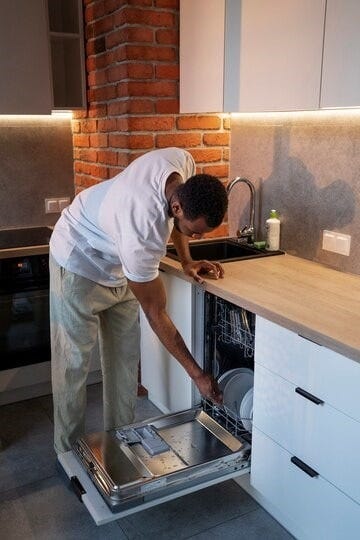
How to clean your dishwasher
Find out more about cleaning your dishwasher with Finish, including which products to use to keep your machine sparkling clean.
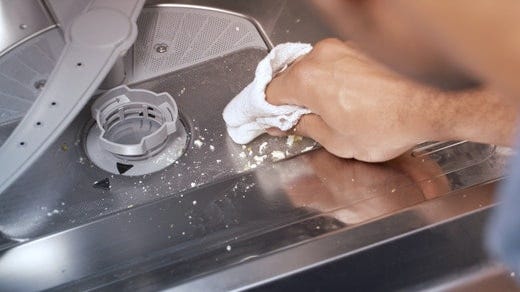
It’s so important to keep your dishwasher in good shape. Any issues with the machine can directly affect how your dishes come out at the end of a wash cycle. Some dishwasher issues could even damage your dinnerware – particularly things like delicate glasses and silver cutlery. Keeping your dishwasher maintained also reduces the chance that you’ll need to carry out major repairs or replacements. We’ve covered the basics of how to maintain your dishwasher below.
Cleaning and caring for your dishwasher
While your dishwasher’s job is to clean dishes, the process can cause the machine itself to become dirty. Food, grease and grime can get caught in its various parts, limescale can build up, and regular use can also wear out the machine. Keeping your dishes sparkling clean means practicing regular dishwasher maintenance, so you don’t have to deal with bigger problems down the line. So, add cleaning the dishwasher to your kitchen cleaning to-do list, making sure you cover all the key elements related to dishwasher care. We cover the basics below.
Cleaning your dishwasher interior
There are several parts in the inside of a dishwasher that need regular upkeep. But, unless you have a specific problem, you may be able to get away with giving the entire machine a good clean in one go using a good quality dishwasher cleaner. You’d have to do this on a regular basis to prevent any issues in the future. We’ve outlined just how to do this in our step-by-step guide to cleaning your dishwasher interior (we may have snuck a few tips for keeping the outside of your dishwasher looking pristine too!).
Checking and cleaning the filter
Giving your dishwasher a regular, general clean is always a good idea. However, you may also encounter specific issues that require closer examination of certain parts of the dishwasher. Alongside, it's crucial to be aware of common dishwasher cleaning mistakes.
If your machine isn’t cleaning or draining properly, the dishwasher filter could be to blame. It’s responsible for protecting the drain pump from getting clogged by food debris and helps prevent food remnants from making it back onto your dishes. If the filter is blocked, you’ll need to clean the filter thoroughly under running water. If you live in a hard water area, use Finish dishwasher cleaner or Finish In Wash Dishwasher Cleaner to help remove any stubborn limescale.
Of course, once you inspect your dishwasher filter, you may instead find that the filter is damaged or broken. Fortunately, it’s usually a simple case of finding a replacement part and swapping the old for the new.
Unblocking and cleaning the drain
If you’ve sorted out your filter and you’re still having issues, you might need to dive deeper into your dishwasher (figuratively speaking, of course!). Behind the dishwasher filter is the drain, which is in equal danger of getting clogged by food debris, grease and grime or becoming damaged over time. To prevent your dishwasher from getting clogged, use Finish dishwasher cleaner regularly in an empty dishwasher on its hottest cycle.
Still having problems? You may need to manually unblock the drain. Turn off the electricity, remove as much water from your dishwasher as possible and find your drain hose. You’ll need to disconnect it and clear it out using something like a pipe cleaner designed to unblock drains. Then, simply reverse the steps to connect the drain back onto the machine. For advice on how to manually unblock the drain, we also recommend you to consult your dishwasher manual.
How to clean dishwasher spray arms
Unless you’re cleaning your dishwasher on a regular basis, you may find that food debris and limescale gets built up on the spray arms of the machine. Learn how to clean dishwasher spray arms so you can jump into action as soon as you spot a problem. Here’s what to do if your dishwasher spray arm gets clogged:
- Empty your dishwasher and remove the bottom rack completely.
- Remove the spray arms located at the middle and top of the machine. You may need to use a ratchet or other appropriate tool.
- Check all the holes in the spray arms for food debris. How do you get food out of dishwasher arms? Use a toothpick, steel wire or pipe cleaner to gently scrub it away.
- Reinstall the spray arms back in the machine and run a cycle without dishes in it to rinse and dry the parts. Don’t forget to pop in a Finish Dishwasher Cleaner for a thorough clean.
For advice on how to manually clean dishwasher spray arms, we also recommend you to consult your dishwasher manual.
How to fix a leaking dishwasher
Leaky dishwasher getting you down? Some of the most common causes of a dishwasher leaking centre around the various internal parts.
For example, your dishwasher may overflow if the water inlet valve is broken. This valve is responsible for allowing water to enter the dishwasher from your main water line, so if it breaks, it could be letting water in willy-nilly. This could also be a reason why your dishwasher is leaking when not running. You can usually spot a leaking water inlet valve by removing the bottom plate on the front of your dishwasher and checking if there’s a slow drip coming from the top of the valve.
Other possibilities for your dishwasher leaking water include defective pumps, damaged hose clamps and a malfunctioning float, and float switch. Fortunately, all these parts can be replaced as long as you know how to spot them:
- Your dishwasher pumps are located at the bottom of your dishwasher. It usually has two separate compartments – one that’s responsible for washing and another responsible for draining water. If it has visible signs of damage, it’ll need to be replaced.
- Hose clamps secure the drain hose and circulating hose to the dishwasher. To get to it, you’ll need to remove the kickplate outside your dishwasher, at the very bottom. Check that the clamps are secure, tightening them with a screwdriver if they’re not. If they look broken, they’ll need to be replaced. You could do it yourself, but it may be safer to call in an expert for this job.
- The float, and float switch work together to prevent the dishwasher from overfilling. The float is located at the bottom of the dishwasher inside the tub and the float switch will be directly below it. If the water level in your dishwasher is too high, you may need to replace the float, and float switch. How do you check? Turn on a cycle and listen out for the tub being filled. As soon as you hear the water has stopped, open the dishwasher door and check how much water is in there. If the float is submerged in water or lifted all the way up, the water level is too high and a replacement job might be in order!
For advice on how to manually fix a leaking dishwasher, we also recommend you to consult your dishwasher manual.
Damaged door seals could cause leakage, too
It makes sense that a damaged door seal could allow water to leak out. Broken door seals could also be to blame if your dishwasher is leaking during the drying cycle – allowing moisture to escape through the gaps.
Check around the door and inspect the seal for signs of wear and tear or damage. Upper seals are easier to replace than lower door seals (you’ll have to remove the door itself for the latter!). Sometimes door seals could simply come out of alignment – just push it back into place to solve the problem!
What if my dishwasher is leaking soap?
If your dishwasher is leaking soap or suds, the most likely culprit is using too much detergent, or the wrong type. A good quality detergent like the Finish Quantum Max can come in extremely handy if you’re facing this problem over and over again. Remember, never use regular dish soap in the dishwasher – you’ll need to stick to dishwasher detergents or you’ll risk damaging the machine!
As we’ve covered, there could be a variety of reasons why your dishwasher isn’t performing to its best ability. Learning more about dishwasher maintenance can be extremely helpful in fixing the problem quickly before it escalates into a massive repair job.
